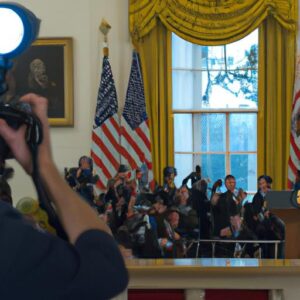Introduction
Art is often perceived as a form of creative expression that ignites emotions, challenges perspectives, and sparks conversations. However, when it comes to photography, the question arises: is it considered art? In this article, we will delve into the intriguing relationship between photography and art, exploring the depths of this captivating medium.
To begin, let’s establish the definitions of photography and art. Photography, at its core, is the art and practice of capturing light to create images. It involves the use of cameras and lenses to freeze moments in time, preserving them for eternity. On the other hand, art encompasses a broad spectrum of creative expressions that evoke aesthetic or emotional responses. It can be painting, sculpture, music, literature, and yes, even photography.
The relationship between photography and art is a fascinating one, often stirring debates and discussions among enthusiasts. Some argue that photography lacks the artistic qualities found in traditional art forms. They claim that photography simply captures reality, leaving little room for interpretation or manipulation. However, this view fails to acknowledge the immense creativity and skill required to produce captivating photographs.
Photography possesses several elements that align with the principles of art. Composition and framing play a crucial role in creating visually appealing photographs. The careful arrangement of subjects, lines, and shapes within the frame can evoke a sense of harmony or tension. Lighting and shadows add depth and dimension, transforming an ordinary scene into an extraordinary work of art. Perspective and depth, color and tone, and the ability to convey emotions and tell stories all contribute to photography’s artistic value.
As we explore the captivating world of photography as an art form, it becomes evident that it is more than just capturing reality; it is about capturing moments, emotions, and narratives. Photography allows us to freeze time, preserving fleeting moments that evoke emotions and transcend boundaries. In the following sections, we will delve deeper into the historical perspectives, the elements of art in photography, and the controversies surrounding its artistic recognition. So, join me on this journey as we unravel the enigmatic connection between photography and art.
Historical Perspective
Early Debates on Whether Photography Can Be Considered Art
In the early days of photography, there were heated debates regarding its status as an art form. Skeptics argued that photography was merely a mechanical process, lacking the creative touch and subjective interpretation found in traditional art forms. They questioned whether the mere act of capturing reality through a lens could be considered a form of artistic expression.
Pioneers Who Established Photography as an Art Form
Despite the initial skepticism, several pioneers emerged and paved the way for photography’s recognition as an art form. Visionaries like Alfred Stieglitz, Ansel Adams, and Henri Cartier-Bresson challenged the notion that photography was a mere mechanical process. They pushed the boundaries of the medium, experimenting with composition, lighting, and subject matter to create captivating and thought-provoking images.
Evolution of Photography as an Artistic Medium
Over time, photography evolved and embraced various artistic movements, becoming a powerful medium for creative expression. The emergence of photography as an art form coincided with the birth of modernism, where artists sought to break traditional norms and explore new perspectives. Photographers, too, embraced this spirit of experimentation, pushing the boundaries of what was considered “acceptable” in the art world.
With advancements in technology, photography became more accessible to the masses, leading to the democratization of art. This accessibility allowed photographers from diverse backgrounds to express their unique visions and narratives through the lens. Photography began to capture not only the external world but also the inner emotions and thoughts of the artist, blurring the lines between reality and imagination.
The historical perspective on photography’s journey as an art form showcases the resilience and creativity of photographers throughout the years. They have challenged conventions, pushed boundaries, and captured the essence of the human experience. In the next sections, we will explore the elements of art in photography and delve deeper into the expressive and storytelling capabilities of this captivating medium. Stay tuned as we unravel the artistic potential of photography!
Elements of Art in Photography
Photography, like any other form of art, encompasses various elements that contribute to its aesthetic appeal and artistic value. Let’s delve into some key elements that make photography a truly artistic medium.
A. Composition and Framing
Composition is the art of arranging elements within a photograph to create a visually pleasing and engaging image. It involves considering the placement, balance, and relationships between subjects, lines, shapes, and negative space. By skillfully composing a photograph, photographers can guide the viewer’s eye, evoke emotions, and convey meaning.
B. Lighting and Shadows
Lighting plays a vital role in photography, as it can drastically transform the mood, atmosphere, and overall impact of an image. Photographers harness the power of light to create depth, highlight or obscure certain elements, and evoke emotions. Shadows, in particular, add dimension and drama, creating a play of light and darkness that can enhance the visual storytelling.
C. Perspective and Depth
Photography allows us to capture scenes from unique perspectives, offering viewers a fresh outlook on the world around them. By experimenting with different angles, focal lengths, and depth of field, photographers can create a sense of depth and three-dimensionality in their images. This adds visual interest and draws the viewer into the photograph, creating an immersive experience.
D. Color and Tone
Color and tone are powerful tools in photography that evoke emotions, set moods, and convey narratives. Photographers can manipulate color through techniques like color grading and selective color, enhancing or altering the impact of an image. Similarly, tone, which refers to the brightness and contrast of an image, can be adjusted to create a specific mood or emphasize certain elements.
E. Emotional Expression and Storytelling
Photography has the unique ability to capture and convey emotions, telling stories without the need for words. Whether it’s a portrait that captures the vulnerability of a subject or a landscape that evokes a sense of tranquility, photographs have the power to evoke powerful emotions in viewers. Through composition, lighting, perspective, and other artistic elements, photographers can craft narratives that resonate with their audience.
In conclusion, the elements of art in photography go beyond the mere act of capturing reality. Composition, lighting, perspective, color, and emotional expression all contribute to the artistic value of a photograph. These elements allow photographers to create captivating images that transcend the boundaries of reality, immersing viewers in a world of visual storytelling. In the following sections, we will explore how photography serves as a form of expression and delve into the criticisms and controversies surrounding its artistic recognition.
Photography as a Form of Expression
Photography goes beyond being a mere documentation of reality; it serves as a powerful tool for self-expression, enabling photographers to convey their subjective experiences, emotions, and perspectives. Let’s explore how photography serves as a medium for expression and communication.
A. Capturing subjective experiences and emotions
Photography allows individuals to capture their unique experiences and emotions in a tangible form. Through the lens, photographers can freeze moments that hold personal significance and evoke deep emotions. Whether it’s a breathtaking landscape, a candid portrait, or an abstract composition, photographs can convey the photographer’s state of mind, their joys, sorrows, and everything in between. The ability to freeze a moment in time allows photographers to share their personal narratives and connect with viewers on an emotional level.
B. Communicating social and cultural messages
Photography has long been used as a tool to shed light on social and cultural issues. By capturing compelling images of people, places, and events, photographers can raise awareness, provoke thought, and ignite conversations. Photographs have the power to depict social inequalities, document historical events, and challenge societal norms. They serve as a visual language that transcends barriers, allowing photographers to communicate powerful messages that can inspire change and foster dialogue.
C. Photography as a medium for self-expression
Photography provides individuals with a platform for self-expression, allowing them to showcase their unique perspectives and artistic vision. Through composition, lighting, and subject selection, photographers can create images that reflect their personal style and creative choices. Each photograph becomes a reflection of the photographer’s personality, thoughts, and emotions. Whether it’s through the use of vibrant colors, unconventional angles, or experimental techniques, photographers can push the boundaries of traditional aesthetics and express their authentic selves.
In conclusion, photography is not limited to capturing what the eye sees; it serves as a vehicle for expression, allowing photographers to communicate their subjective experiences, convey social messages, and express their individuality. Through the art of photography, we can explore the depths of human emotions, challenge societal norms, and celebrate the diversity of perspectives. So, grab your camera and let your creativity soar as you embrace the power of photography as a form of expression.
Criticisms and Controversies
A. Challenges to Photography’s Status as Art
Photography has faced its fair share of challenges in being recognized as a legitimate art form. Some critics argue that photography lacks the authenticity and originality found in other art forms. They contend that anyone can pick up a camera and capture an image, diminishing the skill and craftsmanship associated with traditional art mediums. Additionally, the reproducibility of photographs raises questions about their uniqueness and artistic value.
B. Arguments against Photography as a Creative Endeavor
Detractors of photography as art often claim that it is a passive medium that simply reflects reality without the artist’s intervention. They argue that photographers merely capture what is already there, limiting their ability to convey personal emotions or messages. Furthermore, the advancements in technology and the prevalence of smartphone photography have led to an influx of amateur photographers, diluting the perception of photography as a serious artistic endeavor.
C. Counterarguments Defending Photography as an Art Form
Despite the criticisms, there are compelling counterarguments defending photography as a true art form. Photography requires technical skills, artistic vision, and a keen eye for composition. Photographers make deliberate choices regarding framing, lighting, and subject matter, effectively manipulating reality to convey their intended message. Additionally, photographs have the power to evoke emotions, challenge perspectives, and tell stories, much like any other art medium.
Moreover, photography has been embraced and showcased in art galleries and museums worldwide. Renowned photographers such as Ansel Adams, Diane Arbus, and Henri Cartier-Bresson have solidified its place within the art world. Photography’s ability to capture social issues, document history, and inspire change further strengthens its claim as an art form.
In the midst of the controversies surrounding photography’s artistic status, it is vital to recognize the subjectivity in defining art. Art is a deeply personal and interpretive experience, and what resonates with one person may not with another. While some may dismiss photography’s artistic merit, countless others cherish it as a powerful medium of expression.
As we navigate the complexities of defining art and challenging traditional notions, it becomes apparent that photography has earned its place among esteemed art forms. Its ability to freeze moments, evoke emotions, and communicate narratives makes it an undeniable form of artistic expression. So, let us embrace the captivating fusion of photography and art, appreciating the unique perspectives and stories it has to offer.
Conclusion
In conclusion, the question of whether photography is considered art is a complex one. While some may argue that photography lacks the subjective and interpretive qualities found in traditional art forms, it is undeniable that photography possesses its own unique artistic merits. Through composition, lighting, perspective, and storytelling, photographers can create visually captivating and emotionally evocative works.
Photography has evolved over time, with pioneers establishing it as a legitimate art form. It has the power to capture and express subjective experiences, communicate social and cultural messages, and serve as a powerful medium for self-expression. The artistic value of photography should not be dismissed based on preconceived notions or rigid definitions.
At its essence, art is subjective. It is a form of creative expression that evokes emotions, challenges perspectives, and sparks conversations. Photography, with its ability to freeze moments in time and evoke emotions, undoubtedly fits within this realm of artistic expression. Whether capturing the sublime beauty of nature, the raw emotions of individuals, or the complexities of society, photography has the power to move and inspire.
As we navigate the ever-evolving world of art and photography, it is crucial to recognize the subjectivity in defining art. Perspectives may differ, and debates may arise, but what remains constant is the undeniable impact photography has had on the art world. It has blurred the lines between reality and imagination, challenging us to see the world through a different lens.
So, the next time you encounter a captivating photograph that speaks to your soul, ask yourself: is photography considered art? Allow yourself to embrace the beauty and artistic value that photography holds, and appreciate the unique stories and emotions it conveys. In the end, the answer may lie in the eye of the beholder, as art, after all, is in the eye of the beholder.





